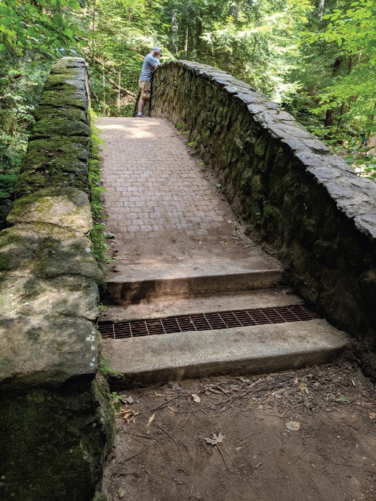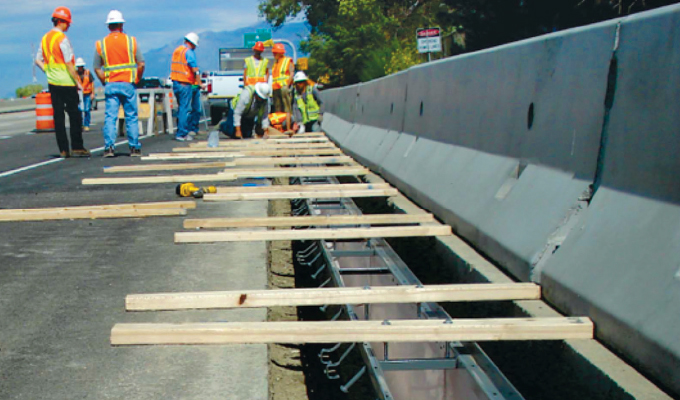Determine the best system to suit your project
By Kristie Polhman
Trench drain systems come in all shapes, sizes, and materials and it can be difficult to determine which system is best suited for your project. Here’s a breakdown on what you need to consider when planning a project that requires trench drain systems.
WHAT ARE THE LOAD REQUIREMENTS FOR THE DRAIN?
Knowing what kind of traffic that will cross over the drainage system is one of the most important factors for you to consider first. There’s a big difference between pedestrian traffic and a commercial airliner and, of course, not all channels are built to take on that kind of weight. You also have to consider that even though the channel may be able to take the weight, it needs to be topped off with grates that are able to mitigate rainwater (or other liquids) while being appropriate for the traffic.
WHAT’S ON TOP?
As with the drainage channels, grates play an important role. They vary in material from plastic and fiberglass to stainless steel and ductile iron. Even areas with pedestrian traffic force you to think about load ratings and material options. Plastic grates may be appropriate for a park landscape or pool side deck but gates at an airport require ductile iron grates with a heelproof and ADA compliant pattern. There are a wide variety of patterns that can control flow rates while providing the correct amount of support. If the area tends to stay water-logged such as in a water treatment plant or around a pool, you can find options that are non-slip and either grip boots tightly or are barefoot friendly. In many cases, you’ll also find options that will blend into the surroundings or designs that enhance the look of the project.
GOING TO EXTREMES?

Another important consideration is knowing what is going to flow through the trench drain system. Some systems are perfect for stormwater but can’t take the extreme heat that it would see in a brewery situation or stand up to corrosive chemicals in a manufacturing facility. If the system is outdoors, it needs to stand up to seasonal freeze-thaw or perhaps extreme heat seen in Texas and Arizona.
KEEPING IT LEGAL
In some cases, projects have to adhere closely to local or federal laws such as MS4 programs or government builds. These can include courthouses, government buildings, or flood control projects. A simple guideline to determine if it’s a state or federal project is knowing who controls the project. A state project can be funded federally but it is still a state-controlled project. However, a state land project may have the US Army Corps of Engineers working on it which then makes it a federally controlled project. It’s not a topic that can be covered easily since each state has a separate set of guidelines and laws to follow.
SURROUNDING LANDSCAPES
Trees, mulch, and stone are just a few of the possible types of debris that have the potential to obstruct the flow of a trench drain system. Make sure you know the plans for the landscape and surroundings. Any trees planted too closely have the potential for roots to interfere with the channels. Likewise, trees can create seasonal debris that can also clog up a system. Stones in some parking areas can get knocked into channels if the grate openings are large enough causing the stormwater flow rate to drop.
Another landscape consideration is the land itself. Is there a natural slope to the area? How much solid surface area will there be versus the amount of green space for water to naturally absorb? You can take it a step further and look at what the soil is composed of. Why is it important? You won’t be able to rely on clay to help disperse stormwater.
LONG-TERM MAINTENANCE
Is there a maintenance program planned for the drainage system? It may seem trivial now, but we have just about seen it all: trenches completely filled with silt at the bottom of a ramp and sand-filled drains at the beach that are rendered ineffective. We frequently see warehouses with cracked and/or partial grates that hopped and broke over time from not having locking devices. It’s a potential hazard at airports where jets can easily lift grates and locking devices if they are not properly secured. Seasonal checks and cleanouts would be beneficial to the system for it to remain effective.

EXPECT THE UNEXPECTED
We always say that it’s better to plan for a hundred-year flood than to explain why you didn’t plan for a hundred-year flood. The system you choose may not be able to keep a hurricane at bay, but if you plan well, you will help the waters to recede faster.
CLOSING THOUGHT
Even when you take everything into consideration, you may still feel overwhelmed by all the possible configurations. Luckily, there are experts that can help you through the decision-making process.


